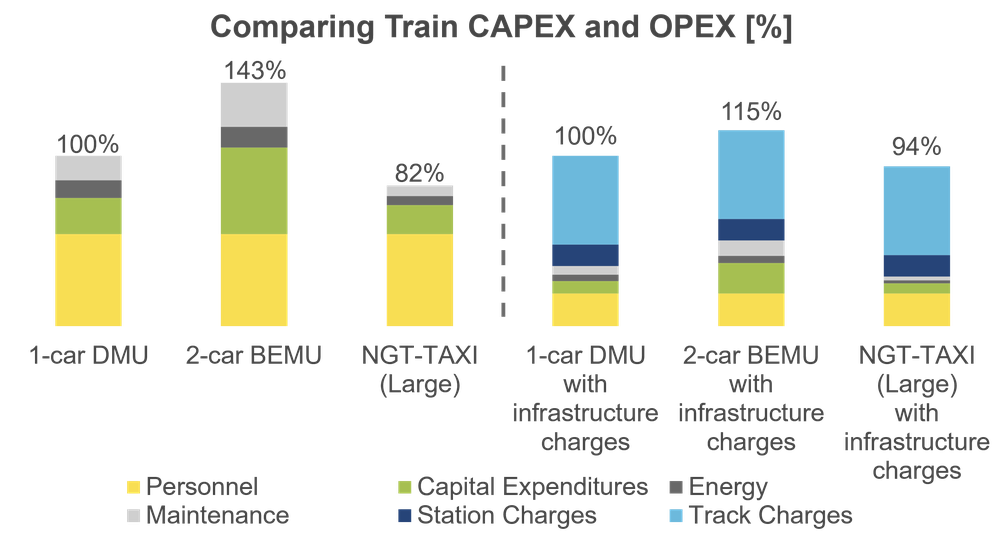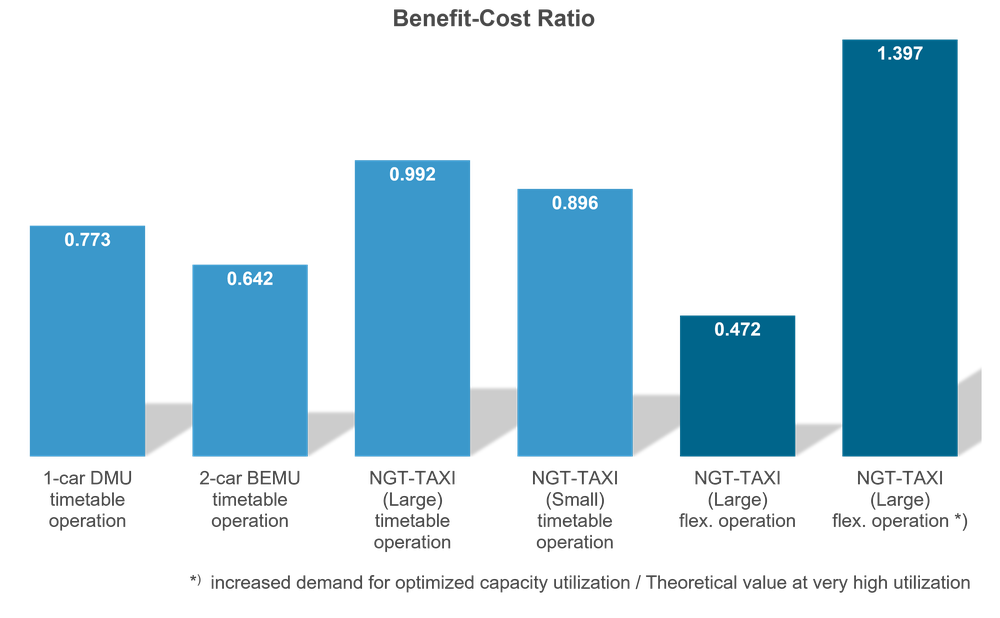NGT-TAXI - Business Case Analysis
An evaluation of the NGT-TAXI was carried out on the basis of two vehicle variants and two use cases. The innovative NGT-TAXI vehicle concept is a short, light and modular rail vehicle, which is equipped with a catenary-independent zero-emission powertrain. It is primarily suitable for branch lines and reactivated secondary routes with low passenger demand. The capacity can be increased by virtually coupling the units during peak times.
The evaluation was done using an operational simulation and a benefit-cost analysis. This method compares the benefits achieved through changes in operating costs and modal shift with the costs of the necessary upgrading of the railway line to be reactivated. Here, a comparison is made between innovative vehicle and operating concepts compared to conventional operation with vehicles available on the market.
Due to lower vehicle capital expenditures, operating and energy costs, the NGT taxi achieves higher benefit-cost ratios of 0.3-0.5 compared to a diesel-powered multiple unit. In these studies, a benefit-cost ratio of 1 or higher was only achieved with the NGT-TAXI (the social benefit is higher than the infrastructure investment). Demand-driven flexible operation can further increase the benefit-cost ratio considerably if further modal shift is achieved through better connections and shorter journey times (Benefit-Cost ratio up to 1.4)
NGT-TAXI - Vehicle concept
The NGT-TAXI is a small, lightweight and modular rail vehicle concept that has been specially developed for operation on branch lines with low passenger volumes. The modular vehicle concept allows the vehicle to be adapted to the particular routes in terms of capacity and drive train. Virtual coupling allows several vehicles to be coupled to form a train set, making it possible to adjust capacity over the day. Two variants were analysed in this study: The NGT-TAXI Small for operation in isolated lines and the NGT-TAXI Large in mixed operation with standard main line rail vehicles.
Variant | NGT-TAXI (Small) | NGT-TAXI (Large) |
|---|---|---|
Length | 11.25 m | 16.7 m |
Seating capacity | 16 | 40 |
Speed | 80 km/h | 120 km/h |
Autonomy | up to 80 km (adaptable number of battery modules) | up to 80 km (adaptable number of battery modules) |
Axle load | < 10 t | < 16 t |
Traction system | Battery electric | Battery electric |
Traction power | 280 kW | 450 kW |
Evaluation
The cost-benefit analysis is based on the with solution / without solution principle and results in a benefit-cost ratio. In this process, the difference of the with solution benefits and the without solution benefits is divided by the infrastructure investments for the implementation of the reactivation project. If the benefit-cost ratio is >1, the project can be said to be economically viable. Various NGT-TAXI (Small and large) operational concepts are compared with bus transport in the without solution scenario. The evaluation was carried out in line with the ‘Vereinfachtes Verfahren für Streckenreaktivierung’ assessment method which is part of the ‘Standardisierte Bewertung 2016+‘.
Use Case A – Mixed Operation
In use case A (mixed operation), the costs of the NGT-TAXI (Large) were compared to a standard two-car battery electric multiple unit (BEMU) and a one-car diesel multiple unit (DMU). A single-track 47.5 km long non-electrified branch line, which is operated at hourly intervals, was used (for further route parameters, see Table X). The vehicle specifications are summarized in Table below.
Route profile | |
|---|---|
Route length [km] | 47.5 |
Stops [-] | 12 |
Demand [pkm/day] | 12 000 |
Interval [min] | 60 |
Travel time [min] | 63 |
Cycle time [min] | 180 |
Battery recharging | At terminal stations |
The sum of train CAPEX (capital expenditures, i.e. vehicle acquisition costs) and OPEX (operational expenditures) of the NGT-TAXI (Large) is around 40 % per year less than that of a two-car BEMU (excl. infrastructure charges) for the discussed variant. The cost comparison is broken down into the relevant cost components in chart below.

Track access charges and personnel costs are identical for all vehicle variants and make up a significant proportion of the total costs. The operation of an NGT-TAXI can offer further potential savings through a driverless operation concept if load-dependent track charges are put in place.
The benefit-cost analysis is shown for the NGT-TAXI, the 2-car BEMU and the 1-car DMU in Fig below for a specific line under investigation. For the assumed transport demand (12,000 passenger-km/day) and necessary infrastructure investments of € 25 million, the NGT-TAXI is the variant with the highest benefit-cost ratio (BCR). The BCR for the NGT-TAXI is just under 1.1, compared to the DMU (0.56) and BEMU (0.02). This results primarily from the lower vehicle costs and the reduced CO2 emissions.

Use Case B - Operation on separate lines
Use case B also included six scenarios to analyse the cost-benefit ratio of operating an NGT-TAXI compared to a DMU and a classic BEMU as part of route reactivation. The following points differ from use case A:
- An isolated route without any railway vehicles on a connecting line linking two major station hubs
- With the same demand (12,000 passenger-km/day), the route is significantly shorter (20.4 km)
- Due to the route characteristics this use case is also suitable for the operation of the NGT-TAXI Small
- In addition to timetable operation, a DRRT (Demand Responsive Rail Transport) operation is also included in the analysis for the NGT-TAXI Large
Further characteristics of the route are shown in the table below:
Route profile | |
|---|---|
Route length [km] | 20.4 |
Stops [-] | 6 |
Travel time [min] | 63 |
Interval [min] | 60 |
Demand [pkm/day] | 12 000 |
The scenario NGT-TAXI Small and the scenario flexible operation require the use of two vehicles instead of one vehicle for scheduled operation when using the DMU, BEMU or the NGT-TAXI Large.
The NGT-TAXI Large achieves a better benefit-cost ratio (0.99) compared to a DMU (0,77+) and a BEMU (0,64) due to lower vehicle costs and other reasons. The higher number of needed vehicles when using the NGT-TAXI Small in regular service increases the operating costs, as a result of which the benefit-cost ratio is approx. 10% lower than when using an NGT-TAXI Large.

If optimum demand is assumed for demand driven flexible operation, a positive benefit-cost ratio of approx. 1.4 can be achieved. The reason for increased demand is an improved service, e.g. through optimised connection quality. The resulting higher transport benefit exceeds the additional operating costs for the second vehicle and the increased vehicle kilometres. If demand does not change (compared to timetable operation), the flexible operation of an NGT-TAXI Large leads to a benefit-cost ratio of 0.47.
Demand Responsive Rail Transport (DRRT)
Demand-responsive concepts such as those used in road-based public transportation are a means to improve the quality of service for passengers and enable more efficient use also for rail vehicles. The NGT-TAXI (Small) offers the potential to transfer these concepts to railway operations: the small vehicle size, automated operation and the possibility of operating on separate lines without occupation conflicts with other rail vehicles make "Demand-Responsive Rail Transport (DRRT)" possible, especially for shorter lines.
DRRT can offer considerable advantages for passengers: Demand-responsive travel options are better suited to passenger needs, requiring no consideration of a fixed, potentially sparse timetable. In addition, more and better connections may be realisable at connecting stations. DRRT is therefore suitable as a feeder service to other regional and long-distance rail services.
The effects on the distance travelled by the vehicles are more multi-layered. During off-peak hours, empty train runs will be avoided, which means that a 24/7 service can in principle be realised without unnecessary expenditure of resources. When passenger demand is high, however, DRRT leads to more train movements and thus a higher vehicle distance, as the bundling effects of a predefined timetable are missing. This can be mitigated, but not completely avoided, by optimizing the distribution of travel requests among the trains.
Therefore, in addition to the previous analysis of variant B, which considered DRRT operation over the whole day, a simulative analysis was carried out for DRRT operation only during off-peak hours from 8 p.m. to 2 a.m. The simulation output is compared with a fictitious hourly timetable.
The following figure shows the average results across multiple simulations for the base case with two vehicles and under the assumption that travel requests are made 5 minutes before the planned start of the journey. We can see a significant improvement in service quality, as passengers can be picked up on average 10 minutes after their preferred departure time - in order to achieve the same effect in a scheduled service, one would have to offer train runs every 20 minutes, resulting in tripling the vehicle distance. In DRRT operation, on the other hand, the distance travelled would only increase from 252 km to 442 km (+75%) for the selected line.

Different factors influence the efficiency of DRRT operation: Sufficient pre-booking time enables the planning algorithm to better coordinate the vehicles. Positive effects can also be observed if demand is particularly concentrated on certain parts of the route, as DRRT operation can focus on the highly utilized segments and avoid unnecessary journeys on less busy sections. Last but not least, efficiency gains can be achieved by limiting the number of vehicles in DRRT operation.
As an example, assuming a halved and more concentrated demand compared to the base scenario and operating only one NGT-TAXI, it is still possible for passengers to travel on average 16 (instead of 30) minutes after their preferred travel time, while the vehicle distance can even be reduced from 253 km to 220 km (-13%) compared to regular hourly operation. This efficiency gain is particularly noticeable in the off-peak hours from midnight to 2 a.m., when DRRT operation avoids unnecessary journeys.
Contact
Dr.-Ing. Christian Meirich
Dr.-Ing. Stephan Schmid

